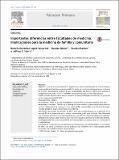Importantes diferencias entre facultades de medicina. Implicaciones para la medicina de familia y comunitaria = Important differences between faculties of medicine. Implications for family and community medicine
Author(s)
Gonzalez Lopez-Valcarcel, Beatriz; Ortun, Vicente; Barber, Patricia; Harris, Jeffrey E.
DownloadHarris_Important differences.pdf (708.0Kb)
PUBLISHER_CC
Publisher with Creative Commons License
Creative Commons Attribution
Terms of use
Metadata
Show full item recordAbstract
Resumen
Objetivo:
Contrastar si hay diferencias significativas entre universidades en la proclividad a elegir medicina de familia y comunitaria (MFyC), dadas las restricciones impuestas por el número de elección. Contrastar la hipótesis de que las facultades que tienen la MFyC como asignatura obligatoria en el grado (3 de 27) presentan mayor predilección por esta especialidad.
Diseño:
Estudio observacional sobre el archivo de datos individuales de elección de plaza MIR en las convocatorias 2003-2011.
Emplazamiento:
España.
Participantes:
Todos los que se presentaron al examen MIR en las convocatorias 2003-2011.
Mediciones principales:
Posición en el ranking de cada candidato, plaza elegida (especialidad y centro), código postal de residencia, sexo, nacionalidad y universidad en la que se ha formado, y código postal del lugar escogido para la residencia.
Resultados:P
Porcentaje de elección de MFyC está muy correlacionado con la posición en el ranking: 8% de los licenciados por la «mejor» universidad, y 46% para la última. Hay diferencias muy notorias y consistentes en la preparación para el MIR entre las 27 facultades de medicina. Ranking en el examen, sexo femenino y ser extranjero ayudan a pronosticar la elección de MFyC. La obligatoriedad de currículum de MFyC de 3 universidades no parece influir en la elección de la especialidad.
Conclusiones:
La conveniente competencia por comparación entre las facultades, su currículum de MFyC, así como la insistencia en los atributos más atractivos de la especialidad pueden contribuir a la necesaria renovación de la MFyC.
Abstract [English]
Objective:
To determine if there are significant differences between universities in the proclivity to choose Family and Community Medicine (FCM), given the constraints imposed by the number of choice. To test the hypothesis that the Schools of Medicine that have the FCM as a compulsory subject in the degree (3 of 27) had the highest preference for this specialty.
Design:
Observational study on the data file of all the individuals taking the MIR examination between 2003 and 2011.
Location:
Spain.
Participants:
All those who sat the examinations called by MIR 2003-2011.
Main measurements:
Position in the ranking of each candidate, elected position (specialty and center), post code of residence, sex, nationality and university in which they studied, and post code location for the residence chosen.
Results:
The percentage electing FCM is highly correlated with the position in the ranking: 8% of graduates for the ‘best’ college, 46% for the worst. Very noticeable and consistent differences in the preparation for the MIR among the 27 medical schools. Ranking in the exam, female and foreigner, help predict the choice of FCM. The FCM compulsory curriculum from three universities does not seem to exert any influence.
Conclusions:
The convenient yardstick competition between the schools of medicine, FCM in their curriculum and the emphasis on the most attractive attributes of the specialty can contribute to the necessary renewal of FCM.
Date issued
2014-03Department
Massachusetts Institute of Technology. Department of EconomicsJournal
Atención Primaria
Publisher
Elsevier B.V.
Citation
González Lopez-Valcarcel, Beatriz, Vicente Ortún, Patricia Barber, and Jeffrey E. Harris. “Importantes Diferencias Entre Facultades de Medicina. Implicaciones Para La Medicina de Familia y Comunitaria.” Atención Primaria 46, no. 3 (March 2014): 140–146. © 2013 Elsevier España, S.L.
Version: Author's final manuscript
ISSN
02126567
1578-1275